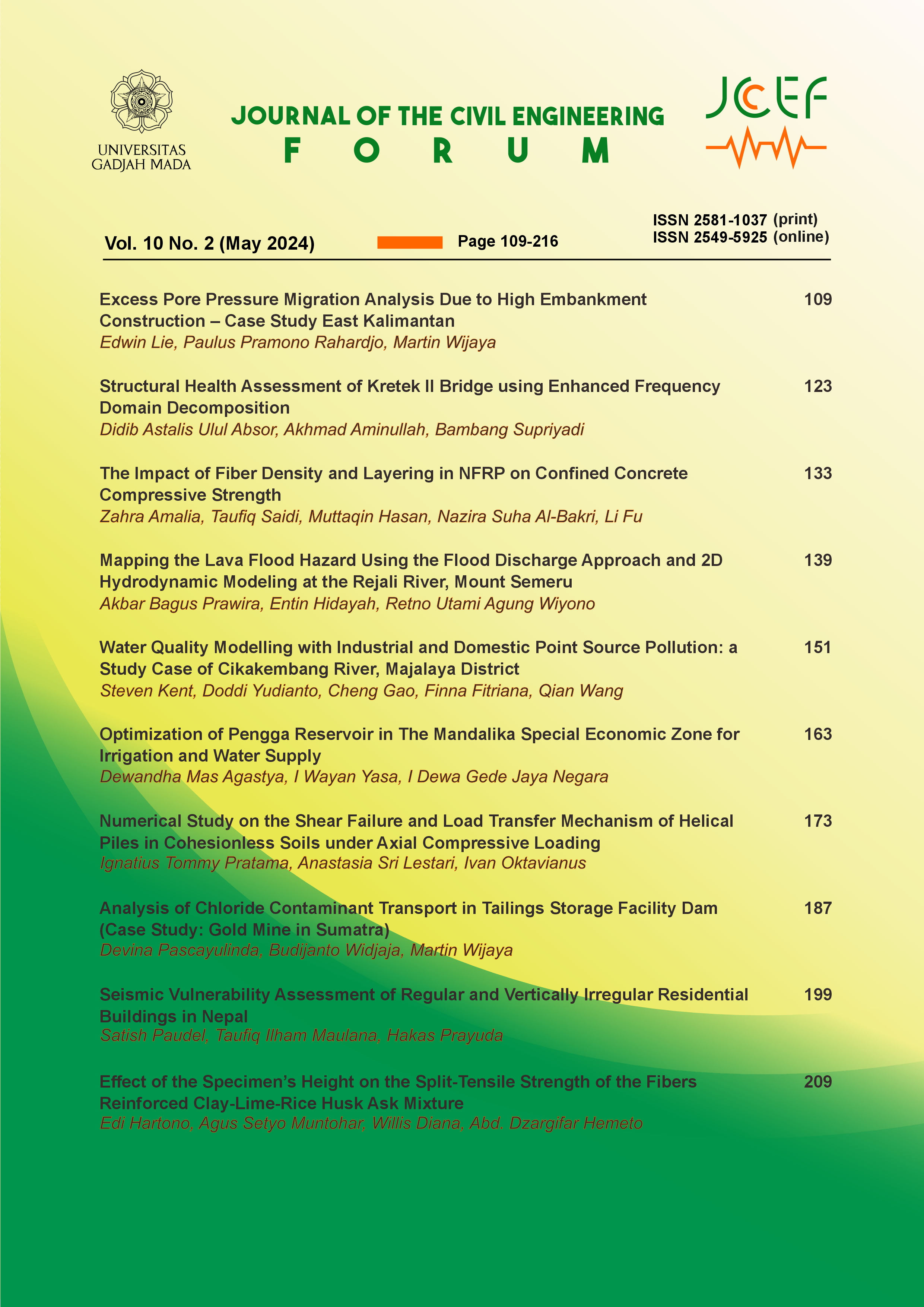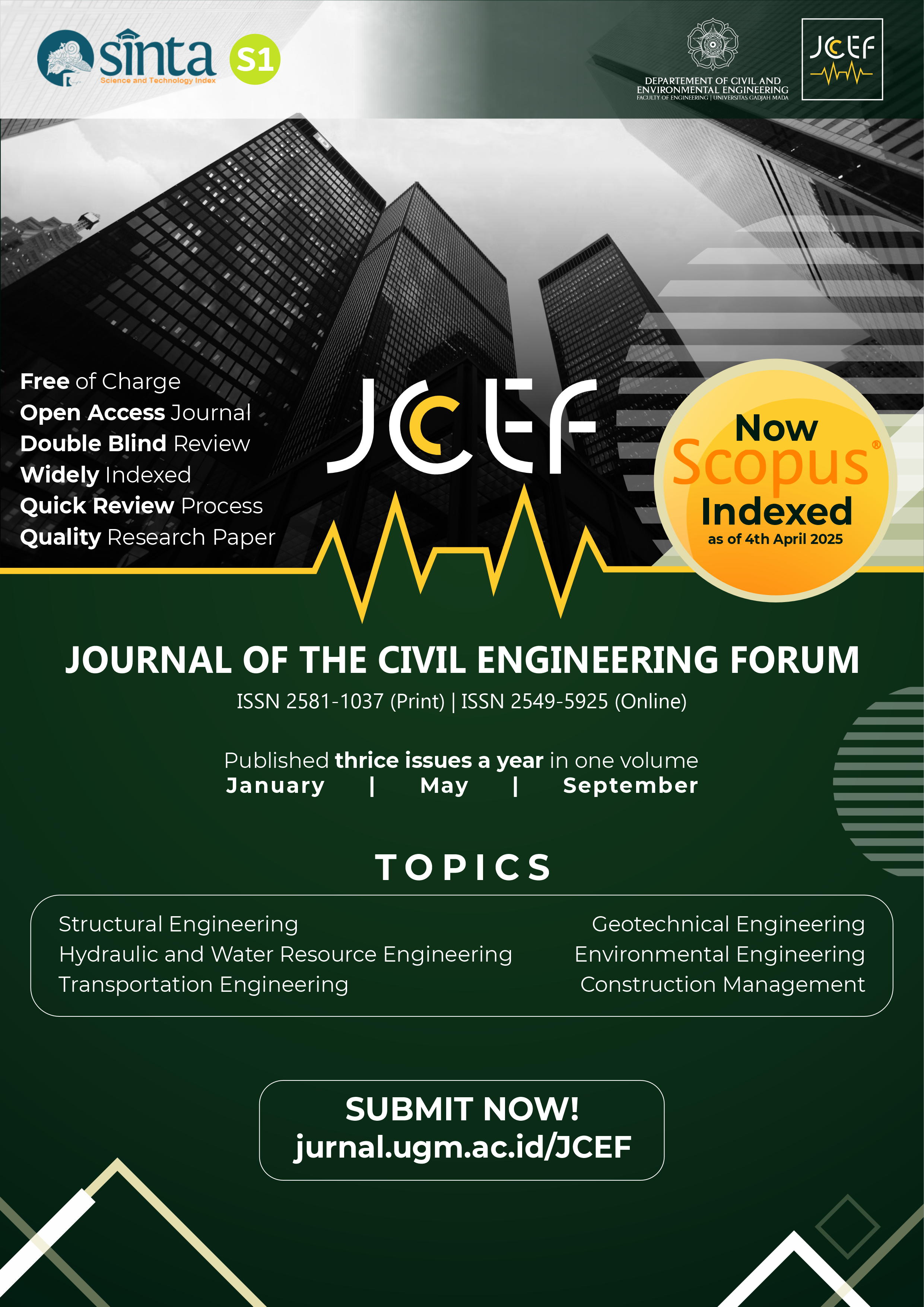Numerical Study on the Shear Failure and Load Transfer Mechanism of Helical Piles in Cohesionless Soils under Axial Compressive Loading
Abstract
The methods employed to calculate the axial bearing capacity of a helical pile depends on the shear failure model around the pile, which is also influenced by the spacing and diameter of the helical plates. However, studies on the transition of the failure mode and the load transfer mechanism with the change of helical plate spacing and diameter in cohesionless soil subjected to axial compressive load have been limited. Thus, this paper investigated the effects of helix diameter and spacing on the axial compressive load-bearing capacity, shear failure model, and load transfer mechanism of helical piles with two helical plates embedded in the homogeneous medium and dense sands, as well as in the stratified medium to very dense sand. Axial loading tests on helical piles with various helix diameters and spacings were simulated using a two-dimensional finite element program with axisymmetric modeling to obtain the load-settlement curve, which was later used to estimate the ultimate bearing capacity of the helical piles. The ultimate bearing capacity of the helical piles was also computed using the conventional methods, i.e., the individual bearing and cylindrical shear methods, and then compared to the numerical-based axial bearing capacity. The stress-strain behaviors of pile and soil were modeled using the Linear Elastic and Mohr-Coulomb material models, respectively. The results show that the numerical-based ultimate bearing capacity of a helical pile increased with increasing the diameter and spacing of the helix. However, the ultimate bearing capacity computed using conventional methods did not show this trend. Then, the transition from the cylindrical shear to the individual bearing failure mechanism occurred at a spacing ratio (i.e., helical plate spacing divided by its diameter) of about two. Ultimately, the load transfer curves indicate that the helical plates mainly supported the applied load.
References
Adams, J. I. and Klym, T. W. (1972), ‘A study of anchorages for transmission tower foundations’, Canadian Geotechnical Journal 9(1), 89–104. URL: https://doi.org/10.1139/t72-007
Alwalan, M. F. and El Naggar, M. H. (2021), ‘Loadtransfer mechanism of helical piles under compressive and impact loading’, International Journal of Geomechanics 21(6). URL: https://doi.org/10.1061/(ASCE)GM.19435622.0002037
Ben (2023), PLAXIS 2D 2023.1: Material Model Manual 2D.
Deardoff, D., Kortan, J., Malone, J., Olson, K. and Waltz, N. (2021), Foundation Support Works Technical Manual, 4th edn, Supportworks, Inc.
Elsherbiny, Z. H. and El Naggar, M. H. (2013), ‘Axial compressive capacity of helical piles from field tests and numerical study’, Canadian Geotechnical Journal 50(12), 1191–1203. URL: https://doi.org/10.1139/cgj-2012-0487
Fitriana, S. B. A. and Hamdhan, I. N. (2018), ‘Pengaruh jumlah dan diameter helix terhadap daya dukung fondasi helical pile’, RekaRacana: Jurnal Teknil Sipil 4(1), 56. URL: https://doi.org/10.26760/rekaracana.v4i1.56
Kulhawy, F. H. (1986), ‘Limiting tip and side resistance: fact or fallacy?’, International Journal of Rock Mechanics and Mining Sciences & Geomechanics Abstracts 23(3), 108. URL: https://doi.org/10.1016/0148-9062(86)91224-6
Livneh, B. and El Naggar, M. H. (2008), ‘Axial testing and numerical modeling of square shaft helical piles under compressive and tensile loading’, Canadian Geotechnical Journal 45(8), 1142–1155. URL: https://doi.org/10.1139/T08-044
Look, B. G. (2007), Handbook of Geotechnical Investigation and Design Tables, Taylor & Francis.
Lutenegger, A. (2009), ‘Cylindrical shear or plate bearing uplift behavior of multi-helix screw anchors in clay’, pp. 456–463. URL: https://doi.org/10.1061/41021(335)57
Lutenegger, A. J. (2011), Behavior of multi-helix screw anchors in sand, in ‘2011 Pan-Am CGS Geotechnical Conference: 64th Canadian Geotechnical Conference and 14th Pan-American Conference on Soil Mechanics and Geotechnical Engineering’.
Mitsch, M. P. and Clemence, S. P. (1985), Uplift capacity of helix anchors in sand, in S. P. Clemence, ed., ‘Unknown Host Publication Title’, American Society of Civil Engineers (ASCE), pp. 26–47.
Mohajerani, A., Bosnjak, D. and Bromwich, D. (2016), ‘Analysis and design methods of screw piles: A review’, Soils and Foundations 56(1), 115–128. URL: https://doi.org/10.1016/j.sandf.2016.01.009
Mooney, J. S., Adamczak Jr., S. and Clemence, S. P. (1985), Uplift capacity of helical anchors in clay and silt, in S. P. Clemence, ed., ‘Uplift Behavior of Anchor Foundations in Soil’, American Society of Civil Engineers (ASCE), pp. 48–72.
Nabizadeh, F. and Choobbasti, A. J. (2017), ‘Field study of capacity helical piles in sand and silty clay’, Transportation Infrastructure Geotechnology 4(1), 3–17. URL: https://doi.org/10.1007/s40515-016-0036-0
Nasr, M. H. (2004), Large capacity screw piles, in ‘The International Conference: Future Vision and Challenges for Urban Development’, pp. 1–15.
Perko, H. A. (2009), Helical piles: a practical guide to design and installation, John Wiley & Sons, Inc.
Rao, S. N., Prasad, Y. V. S. N. and Shetty, M. D. (1991), ‘The behaviour of model screw piles in cohesive soils’, Soils and Foundations 31(2), 35–50. URL: https://doi.org/10.3208/SANDF1972.31.25
Reese, L. C. and O’NeilO’Neil, M. W. (1988), Report no. fhwa-hi-88-042 - drilled shafts: Construction procedures and design methods, Technical report.
Sakr, M. (2009), ‘Performance of helical piles in oil sand’, Canadian Geotechnical Journal 46(9), 1046–1061. URL: https://doi.org/10.1139/T09-044
Sakr, M. (2011), ‘Installation and performance characteristics of high capacity helical piles in cohesionless soils’, DFI Journal - The Journal of the Deep Foundations Institute 5(1), 39–57.
URL: https://doi.org/10.1179/dfi.2011.004
Salhi, L., Nait-Rabah, O., Deyrat, C. and Roos, C. (2013), ‘Numerical modeling of single helical pile behavior under compressive loading in sand’, Electronic Journal of Geotechnical Engineering 18, 4319–4338.
Soltani-Jigheh, H. and Zahedi, P. (2020), ‘Load transfer mechanism of screw piles in sandy soils’, Indian Geotechnical Journal 50(6), 871–879. URL: https://doi.org/10.1007/s40098-020-00431-5
Sprince, A. and Pakrastinsh, L. (2010), Helical pile behavior and load transfer mechanism in different soils, in ‘10th International Conference “Modern Building Materials, Structures and Techniques,”’, pp. 1174–1180.
Trofimenkov, J. G. and Mariupolskii, L. G. (1965), Screw piles used for mast and tower foundations, in ‘The 6th International Conference on Soil Mechanics and Foundation Engineering’, pp. 328–332.
Vignesh, V. and Mayakrishnan, M. (2020), ‘Design parameters and behavior of helical piles in cohesive soils—a review’, Arabian Journal of Geosciences 13(22), 1194. URL: https://doi.org/10.1007/s12517-020-06165-1
Copyright (c) 2024 The Author(s)

This work is licensed under a Creative Commons Attribution-ShareAlike 4.0 International License.
Copyright is granted to authors for the purpose of providing protection for articles written to describe experiments and their results. JCEF will protect and defend the work and reputation of the author and are also willing to address any allegations of violation, plagiarism, fraud, etc. against articles written and published by JCEF. JCEF is published under the terms of the Creative Commons Attribution-ShareAlike 4.0 International License (CC BY-SA 4.0). The author holds the copyright and assigns the journal rights to the first publication (online and print) of the work simultaneously.





